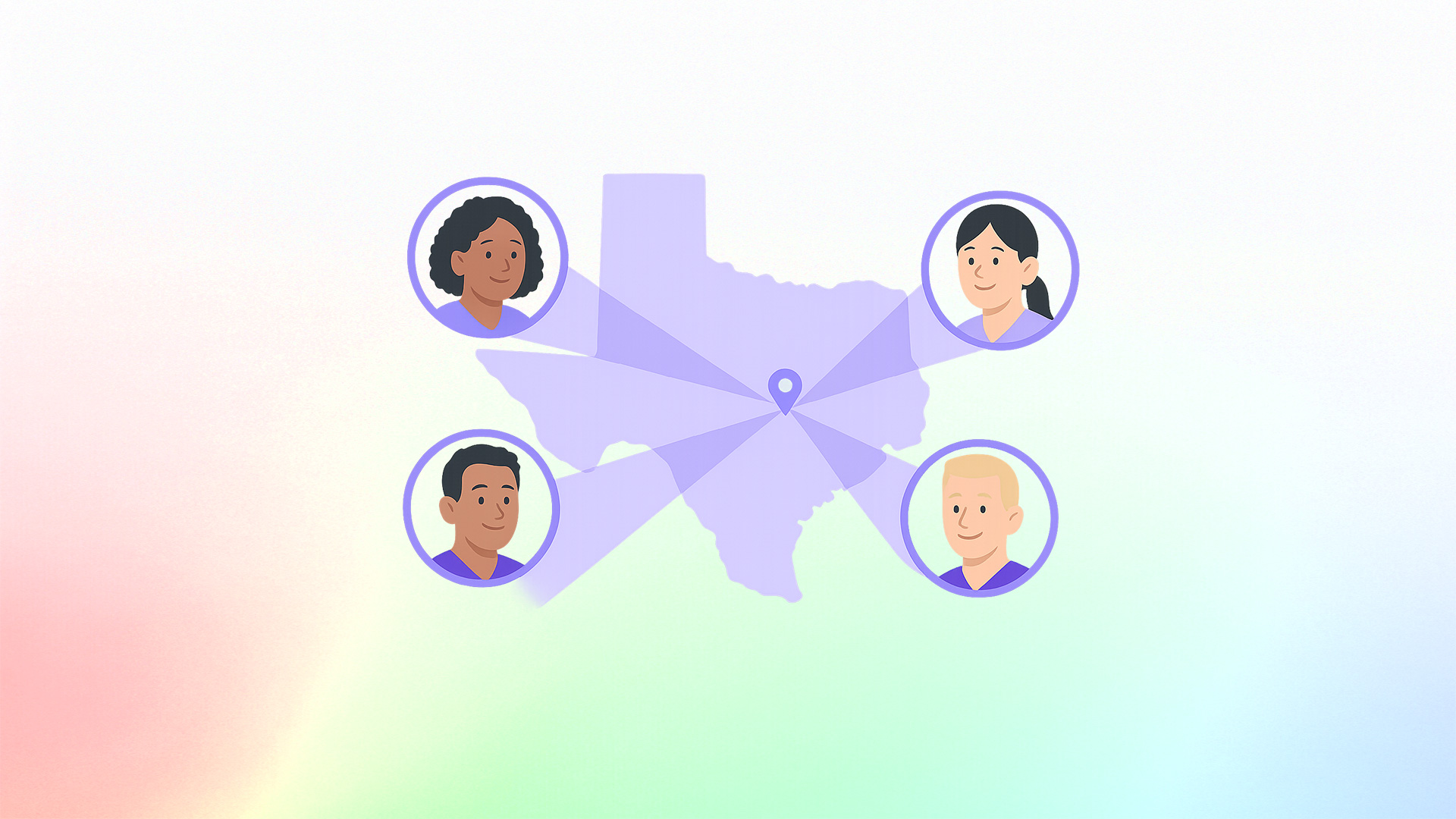Finding a pediatric nurse practitioner preceptor means locating an experienced healthcare professional qualified to supervise your clinical rotations in pediatrics. These clinical preceptors guide NP students through hands-on patient care, help them meet program competencies, and prepare them for board certification. Because of an ongoing national shortage of pediatric NP preceptors, students often rely on preceptor matching services like NPHub to connect with verified professionals and complete their clinical placements on time.
TL;DR: How to Find PNP Preceptors
- Preceptor shortages are real. The U.S. faces an acute lack of pediatric nurse practitioner preceptors, especially outside major hospitals and medical centers.
- Know your program’s needs. Clarify required clinical hours, settings, and preceptor qualifications before reaching out.
- Expand your search. Look beyond pediatric hospitals to family medicine, primary care, and community health clinics that serve children.
- Personalize your outreach. Short, direct messages to potential preceptors are far more effective than generic templates.
- Get help when needed. If your search stalls, create your free NPHub account to connect with verified pediatric NP preceptors who are actively mentoring students.
Why PNP Preceptors Are So Hard to Find Right Now
For many pediatric nurse practitioner students, finding a clinical preceptor is one of the toughest parts of the journey. You can have strong grades, great recommendations, and clear goals, but still spend weeks searching for someone available to teach.
Across graduate nursing education, the shortage of qualified preceptors has become a national concern. Pediatric nurse practitioners and primary care providers are managing full patient loads and higher productivity requirements, which leaves less time to supervise NP students.
At the same time, more nurse practitioner programs are opening each year, increasing competition for limited clinical sites in pediatrics, family medicine, and urgent care.
This matters for every student working toward a pediatric nursing certification. Clinical experience is where theory becomes practice, and where you develop confidence in patient care, communication, and professional judgment.
Without enough clinical placements, students risk delayed graduation, postponed certification, and unnecessary stress during one of the most demanding parts of their program.
If you are struggling to find a placement or running out of time before your next clinical rotation, there is a simpler way forward. Create your free NPHub account to explore available pediatric nurse practitioner preceptors and connect with professionals who are already verified and actively teaching.
With the right support, you can move past the search stage and focus on what really matters, learning how to care for children with skill and confidence.
Before you start reaching out to potential preceptors, it helps to understand the scope of the pediatric nurse practitioner role and what makes it unique. Knowing how your responsibilities fit into pediatric care can make your outreach more focused and your conversations with preceptors far more effective.
The State of the PNP Workforce
To understand why finding pediatric nurse practitioner preceptors is so difficult, it helps to look at the larger picture of the workforce. R
Recent data from the Pediatric Nursing Certification Board (PNCB) shows there are now more than 53,000 certified pediatric nursing professionals in the United States. This includes Certified Pediatric Nurse Practitioners in Primary Care (CPNP-PC), Acute Care (CPNP-AC), and dual-certified providers who care for children, adolescents, and young adults across a variety of settings.
Most pediatric nurse practitioners work in hospitals, outpatient clinics, schools, and private practices. Many combine clinical work with education, research, or administrative roles. CPNP-PCs often focus on community and outpatient care, while CPNP-ACs are concentrated in hospital and critical care environments that require strong clinical skills and advanced acute care training.
The report also shows a workforce that is relatively young but deeply experienced. The average pediatric NP is younger than the national RN average of 52, yet most have years of pediatric-specific experience. Nearly all hold a master’s or doctoral degree, reflecting the increasing academic and professional standards for advanced nursing practice.
Interest in subspecialties continues to grow. Alongside primary care, emergency medicine, and critical care, new areas such as behavioral health, adolescent medicine, and mental health integration are expanding rapidly. The PNCB has introduced new competency programs to support these shifts, preparing the next generation of providers for more diverse and complex pediatric care.
As the field evolves, the need for clinical preceptors grows with it. Enrollment in NP programs continues to increase, but the number of available clinical sites and qualified preceptors has not kept pace. This imbalance directly affects students seeking clinical placements and explains why so many experience long delays when searching for a preceptor.
Understanding these workforce trends can make your search more strategic. Knowing where pediatric NPs are needed most helps you target potential preceptors in areas such as pediatric acute care, community-based primary care, and behavioral health. Approaching your search with that awareness shows preparation and professional insight, qualities that experienced preceptors notice immediately.
If you’ve been reaching out with no response, try a more guided approach. Create your free NPHub account to see verified pediatric NP preceptors who are currently mentoring students. You can browse by specialty, location, and availability, then connect with preceptors whose experience aligns with your goals.
With this in mind, the next step is understanding how to approach your preceptor search differently. Small adjustments in timing, communication, and preparation can completely change your results and help you secure the placement you need to complete your program on schedule.
Why There Aren’t Enough Pediatric NP Preceptors
The shortage of pediatric nurse practitioner preceptors has become one of the biggest barriers to both graduate nursing education and child health in the United States. Recent nursing research identifies an acute lack of PNP preceptors as one of the main causes of the national pediatric nurse practitioner workforce crisis.
Programs that once trained students in smaller communities have closed, shifting most pediatric NP education to large urban medical centers. That shift concentrates both clinical rotations and clinical sites in a handful of locations, where pediatricians and nurse practitioners already face full schedules and limited time for teaching. As workloads rise, fewer are able or willing to take on NP students.
Another key factor is the lack of financial or institutional support for pediatric NP preceptorships. Unlike some adult or family nurse practitioner programs, pediatric-focused training rarely receives federal or state funding. Without incentives or reimbursement, many experienced clinicians cannot afford to spend time precepting students, even when they want to help.
Research also highlights a growing preference among pediatricians to train medical residents rather than pediatric NP students, which further narrows the field of available qualified preceptors. Combined with the absence of formal funding for clinical placements, these patterns have forced many nursing schools to limit admissions to their pediatric NP programs.
The impact of this shortage goes beyond the classroom. Fewer preceptors mean fewer graduates entering the workforce, which directly affects access to care for children enrolled in Medicaid and CHIP. The gap between healthcare demand and provider availability continues to widen, especially in underserved areas where primary care providers are already in short supply.
This situation also limits exposure to diverse practice settings, from community-based primary care to pediatric acute care, behavioral health, and mental health. Students lose opportunities to build real-world skills and confidence in complex clinical settings, and programs lose their ability to train enough nurse practitioners to meet future child health needs.
Experts now recommend developing a broader, non-traditional network of preceptors for pediatric training. That includes partnerships between pediatric NPs, family nurse practitioners, and community-based clinicians who can open new practicum sites for students.
Expanding clinical experiences into rural and underserved communities would relieve pressure on hospital-based clinical preceptors and help build a more equitable workforce for children’s health.
This is not a quick fix, but understanding how the shortage developed gives NP students a more realistic view of the system they’re entering. It also points to where opportunity still exists—and how a strategic approach to finding pediatric NP preceptors can make all the difference.
This shortage is the result of years of funding gaps, administrative barriers, and heavy workloads that leave little room for teaching. But while the system adjusts, there are still ways to move forward.
You can start small by exploring who’s available to teach right now. Create your free NPHub account to see current pediatric NP preceptors who are mentoring students in real clinical settings. It’s a practical first step toward finding guidance, completing your rotations, and keeping your goals in motion.
Now that you know why the shortage exists, let’s look at what you can do differently to find your preceptor and move forward with confidence.
Your DIY Guide to Finding Your Pediatric Nurse Practitioner Preceptor
By now, you already know the system isn’t set up in your favor. Between limited clinical sites, overworked providers, and packed NP programs, finding a pediatric nurse practitioner preceptor can start to feel impossible.
But students are still getting placements and not because they’re lucky, they’ve learned how to work smarter within the system here’s how you can start doing the same.
1. Get clear on what your program actually needs
Before sending any emails, make sure you fully understand your clinical education requirements. That means knowing your total clinical hours, acceptable practice settings, and what qualifies someone as a clinical preceptor.
When you reach out to potential nurse practitioner preceptors, include a one-page summary of these requirements. It shows that you’re organized and saves them time, which is often the biggest barrier to saying yes. Clear communication makes you look professional and ready for graduate-level clinical training.
2. Rethink where you’re looking
If every children’s hospital and pediatric clinic near you is full, shift your focus. Many family medicine, primary care, and urgent care settings see a large number of pediatric patients. These sites often qualify for pediatric NP rotations and may offer more personalized experiences than large institutions.
You can also explore community health centers or clinics in underserved areas, where the need for pediatric nurse practitioners is growing fast. Students who broaden their search tend to find placements sooner and gain a richer view of real-world pediatric care.
3. Make your outreach personal and intentional
Preceptors receive dozens of emails from NP students each semester. If you want to stand out, be specific and human. Introduce yourself, mention your nursing program, and explain what type of clinical experience you hope to gain. Avoid generic lines like “I’m looking for a rotation.” Instead, say something like:
“I’m completing my pediatric track and looking for a site that serves children and families in primary care. I’d love to learn from a provider experienced in developmental and preventive care.”
It’s short, clear, and shows real interest.
If your messages aren’t leading anywhere, take a shortcut. Create your free NPHub account to see verified pediatric nurse practitioner preceptors who are already teaching. You can filter by location, specialty, and availability saving time and avoiding the constant cycle of unanswered emails.
4. Use your network intentionally
Most students underestimate the reach of their own connections. Talk to clinical faculty, alumni, and classmates who’ve already finished their clinical rotations. Many are willing to share leads or introduce you to preceptors they’ve worked with.
Join nursing associations, attend webinars, or participate in continuing education events. Even a five-minute chat can turn into a referral. The more visible you are, the more likely you’ll find someone open to mentoring an NP student who’s eager to learn.
5. Stay persistent but grounded
The search can feel endless, especially when you’re balancing coursework, exams, and life outside school. But persistence matters. Follow up politely, keep records of who you’ve contacted, and celebrate small wins along the way.
When you finally secure your clinical site, it’ll be proof that your persistence paid off. Every message you sent, every call you made, every “no” that led you closer to a “yes”, they all build the confidence you’ll carry into your first day as a pediatric nurse practitioner.
So, don’t stop now. Take a breath, refocus your search, and keep moving forward. The right preceptor is out there, you just need the right plan to find them.
When Doing It Alone Isn’t Working: How NPHub Helps Pediatric NP Students Move Forward
Sometimes, even the most organized pediatric NP students hit a wall. You’ve emailed dozens of clinics, reached out to clinical faculty, and followed every lead your classmates shared yet you’re still waiting for someone to say yes.
That’s where preceptor matching services can change the game.
NPHub was created to take the uncertainty out of finding nurse practitioner preceptors. Instead of starting from scratch with every new contact, you gain access to a verified network of pediatric nurse practitioner preceptors who are already mentoring students in real clinical settings.
Here’s how it helps:
- Verified and qualified preceptors
Every clinical preceptor in NPHub’s network meets the required preceptor qualifications and is reviewed for active licensure and experience. You can search for pediatric NP preceptors in primary care, acute care, or community health—all specialties aligned with NP program requirements. - Streamlined communication and paperwork
NPHub’s team manages the parts that usually slow students down: paperwork, confirmations, and clinical placement coordination. That means you can focus on preparing for your clinical rotations instead of chasing email replies. - Transparency at every step
You can see available preceptors, their practice settings, and what kind of clinical experience they offer before committing. It’s a direct way to match with professionals who are genuinely interested in teaching. - Real human support
You’re not left to figure it out alone. The NPHub support team guides you through the process, helping ensure your clinical placement aligns with your graduate nursing education and program goals.
If your own search has stalled it may be the right moment to create your free NPHub account to explore available pediatric NP preceptors and see which opportunities fit your next clinical rotation.
The system might be difficult, but it’s not unbreakable. With the right support, you can stop waiting for a chance and start preparing for it.
Finding Your Way Forward
If you’ve made it this far, you already understand how much effort this process takes. The search for pediatric nurse practitioner preceptors can feel endless, but every email, every call, and every small step is building the resilience that defines great nurse practitioners.
The shortage is a system problem that’s been years in the making where there's too many NP students but not enough qualified preceptors, and a healthcare structure that hasn’t caught up with its own demand. But that doesn’t mean you’re stuck.
You’ve learned how to organize your search, how to reach out with confidence, and how to use the right resources to keep moving forward. Whether your next opportunity comes from your own outreach or through a verified preceptor matching service like NPHub, what matters is that you keep your progress in motion.
You’re not just trying to finish a clinical rotation, you’re preparing to join a profession that depends on people who care deeply, think critically, and don’t give up when things get difficult. That’s the kind of provider every child and every family deserves.
So take a break, regroup, and when you’re ready, take the next step. Create your free NPHub account, find the support you need, and keep moving toward that first day of clinical practice. You’re closer than you think.
Frequently Asked Questions About Finding Pediatric NP Preceptors
1. Why is it so hard to find a Pediatric Nurse Practitioner preceptor?
The shortage of pediatric nurse practitioner preceptors is tied to multiple factors: heavy clinical workloads, lack of compensation or institutional support, and limited clinical sites for student placements. Many pediatric nurse practitioners already balance patient care, administrative work, and teaching responsibilities, leaving little time to take on NP students.
2. Where do Pediatric Nurse Practitioners usually complete their clinical rotations?
Most pediatric NP students complete clinical rotations in primary care, urgent care, community health centers, or hospital-based pediatric departments. Some also gain experience in behavioral health, emergency departments, and acute care units. Schools often accept a mix of clinical settings to ensure well-rounded exposure to pediatric populations.
3. Can Family Nurse Practitioners or other providers precept Pediatric NP students?
Yes. Many family nurse practitioners and primary care providers see pediatric patients regularly and can serve as qualified preceptors for certain rotations. Always confirm with your school’s NP faculty or clinical education coordinator that the preceptor meets your program’s requirements before starting your clinical placement.
4. How far in advance should I start looking for a preceptor?
Start early—at least three to four months before your clinical rotation begins. Most clinical sites fill their preceptor spots long before each semester starts, and last-minute searches often limit your options. Beginning early gives you time to find, contact, and secure the right preceptor without risking program delays.
5. What should I include when reaching out to a potential preceptor?
Keep your message short and professional. Include your nursing program name and clinical course,the total number of clinical hours you need, your preferred practice setting (primary care, acute care, community health, etc) and any specific learning objectives or patient age groups your program requires. This information shows that you’ve done your homework and makes it easier for a potential nurse practitioner preceptor to decide if they can take you on.
6. What if I can’t find a preceptor on my own?
If you’ve contacted dozens of clinical sites without success, you’re not alone. Many students turn to preceptor matching services like NPHub, which connects NP students with verified pediatric NP preceptors across different specialties and locations. These services help reduce delays and ensure your clinical placement meets program and licensure requirements.
7. How many clinical hours do Pediatric NP students need to complete?
Most pediatric NP programs require between 500 and 700 clinical hours, divided among different practice settingssuch as primary care, acute care, or behavioral health. Your clinical faculty will guide you on the breakdown of hours per rotation and specific skill competencies you need to meet.
8. What happens if my preceptor backs out or my site cancels last minute?
It’s stressful, but it happens. Contact your NP program coordinator immediately to discuss alternatives. Some schools maintain backup lists of clinical preceptors or allow temporary placements while new sites are confirmed. Services like NPHub can also help you quickly find another preceptor so your clinical education stays on track.
9. Are preceptors paid for mentoring students?
Compensation varies by site and region. Some hospitals and private practices offer small stipends, while others treat it as a professional contribution to nursing education. However, the lack of consistent financial support is one of the reasons the preceptor shortage persists nationwide.
10. How do I get started with NPHub?
You can create your free NPHub account, explore available pediatric nurse practitioner preceptors, and view clinical sites in your area. Once you find a match, NPHub manages the coordination, paperwork, and confirmation process—helping you focus on learning instead of logistics.
Key Definitions
- Pediatric Nurse Practitioner (PNP):
An advanced practice registered nurse (APRN) who provides comprehensive healthcare for children, adolescents, and young adults. Pediatric nurse practitioners diagnose and treat illnesses, prescribe medications, promote disease prevention, and deliver health education across diverse clinical settings, including hospitals, outpatient clinics, and community health centers. - Preceptor:
An experienced nurse practitioner, physician, or other qualified healthcare professional who mentors NP students during clinical rotations. A nurse practitioner preceptor provides direct supervision, evaluates student progress, and helps develop essential clinical skills through real-world patient care experiences. - Clinical Placement:
A supervised, hands-on clinical experience where NP students apply classroom knowledge in real healthcare environments. Clinical placements are required components of all graduate nursing education programs and are essential for developing competency in nursing practice and patient management. - Preceptor Matching Services:
Professional platforms, such as NPHub, that connect nurse practitioner students with verified, qualified preceptors. These services streamline the process of securing clinical placements, manage school and site paperwork, and help students complete their clinical rotations efficiently while ensuring compliance with program and licensure requirements. - Clinical Faculty:
Educators within nursing programs who coordinate clinical education, approve clinical sites, and oversee students’ progress throughout their clinical rotations. They act as liaisons between nursing schools, preceptors, and healthcare organizations to ensure students meet academic and professional standards.
About the author
- NPHub Staff
At NPHub, we live and breathe clinical placements. Our team is made up of nurse practitioners, clinical coordinators, placement advisors, and former students who’ve been through the process themselves. We work directly with NP students across the country to help them secure high-quality preceptorships and graduate on time with confidence. - Last updated
October 28, 2025 - Fact-checked by
NPHub Clinical Placement Experts & Student Support Team - Sources and references
- https://www.pncb.org/sites/default/files/resources/PNCB_2022_Pediatric_Nursing_Workforce_Demographic_Report.pdf
- https://pmc.ncbi.nlm.nih.gov/articles/PMC10606953/pdf/nihms-1929654.pdf
- https://www.nphub.com/rotation-paperwork-process
- https://www.nphub.com/preceptor-matching-specialists
- https://www.nphub.com/np-student-coordinators
Find a preceptor who cares with NPHub
Book a rotation.webp)








.webp)


.webp)



.webp)